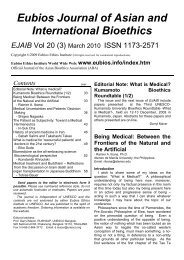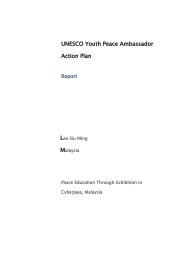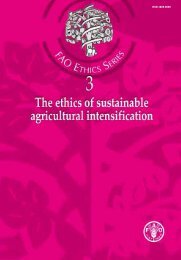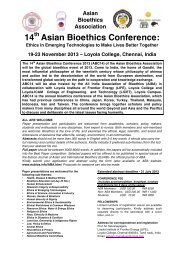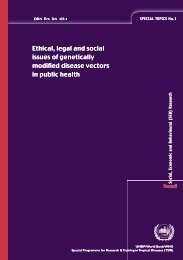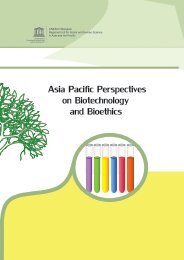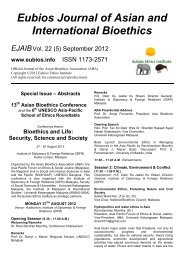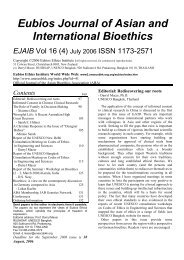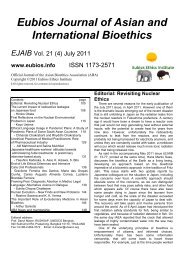Eubios Journal of Asian and International Bioethics EJAIB
Eubios Journal of Asian and International Bioethics EJAIB
Eubios Journal of Asian and International Bioethics EJAIB
- No tags were found...
Create successful ePaper yourself
Turn your PDF publications into a flip-book with our unique Google optimized e-Paper software.
24<strong>Eubios</strong> <strong>Journal</strong> <strong>of</strong> <strong>Asian</strong> <strong>and</strong> <strong>International</strong> <strong>Bioethics</strong> 18 (January 2008)equilibrium, along with; e) the unfair legal dilemma have beenas well discussed. Coupled with personal moral philosophy(which is projected as an individual moral philosophycomposed <strong>of</strong> both relativism <strong>and</strong> idealism for self-governingmagnitudes), <strong>and</strong> moral intensity (defined as theconsideration <strong>of</strong> individual perception <strong>of</strong> bioethical situations),a model depicting the process <strong>of</strong> bioethical decision-making isproposed.IntroductionTransplantation <strong>of</strong> human fetal tissue <strong>and</strong> stem cellresearch are critical issues. There are some who considerelective abortion as an unjust act. In addition, many view thathuman life as non-negotiable entity <strong>of</strong> a human person.Hence, there is much controversy regarding fetal/embryonictissue transplantation <strong>and</strong> stem cell research as they involveor even generate clinical <strong>and</strong> ethical issues. The ethical <strong>and</strong>moral responsibility thus rests heavily upon the shoulder <strong>of</strong>the researcher.Sensitivity to social <strong>and</strong> cultural significance <strong>of</strong> humanbiological tissues including placenta, stem cell, along withumbilical cord blood is to be examined. Critical issues such asrestriction <strong>of</strong> federal funds for research that uses humanembryonic stem (ES) cell due to ethical question like whenhuman life begins is to be addressed. It has been noted thatgreat progress with research has been made, in spite <strong>of</strong>restricted funding. Therefore, the dem<strong>and</strong>s for transparency<strong>of</strong> such research merits discussion. In addition to theaforementioned deliberations, coupled with personal moralphilosophy <strong>and</strong> moral intensity, a model depicting the process<strong>of</strong> bioethical decision-making is herein proposed. Lastly, twohypotheses are introduced, <strong>and</strong> they are followed with theexample on how to properly apply the proposed model.The deliberation on the transplantation <strong>of</strong> “humanembryonic/fetal tissue” is an extremely critical issue.According to Time Magazine, fetal issue transplants could beused to treat leukemia, diabetes, memory deficits, Alzheimer’sdisease <strong>and</strong> Parkinson’s disease, just to name a few.Nevertheless, there are controversies that surround theclinical <strong>and</strong> ethical issues <strong>of</strong> what constitutes the human life,<strong>and</strong> the inviolability <strong>of</strong> that life. With the prospect <strong>of</strong> saving<strong>and</strong> improving life, apprehension over ethical decision-makingin the context <strong>of</strong> bioethics has noticeably increased latelybecause <strong>of</strong> issues <strong>of</strong> fetal <strong>and</strong> embryonic tissue transplant asthe dem<strong>and</strong>ing source <strong>of</strong> such tissue <strong>and</strong> cells, <strong>and</strong> therelated stem cells research. This is parallel to the increasingtrepidation over the exploitation <strong>of</strong> elective legal abortion asthe source <strong>of</strong> transplant <strong>and</strong> research, which is further guidingtowards requests for more studies that search ethicaldecision-making in the context <strong>of</strong> clinical, biomedical, <strong>and</strong>public health. This article answers those requests by firstlaunching on quality analysis with analytical reasoning, in aneffort to provide the argument within the framework <strong>of</strong> existingbioethical principles. Then I advance to explore some <strong>of</strong> themajor current problems. While the two sides <strong>of</strong> the argumentsare polarized, there should be a middle ground between theneed to protect life in all its phases <strong>and</strong> the prospect <strong>of</strong>improving well-being <strong>and</strong> saving lives in all its stages relatedwith embryonic stem cells research.The Background <strong>of</strong> ArgumentsResearchers/scientists have identified fetal transplants,<strong>and</strong> embryonic stem cells (ES cells) from humans as themajor sources <strong>of</strong> stem cell research, among which ES cellsare the most controversial. Definitely, we cannot all agree thata fetus is a person, while any personal opinion may be statedas merely a suggestion. After all, what is a ‘person’?According to the Compact Oxford Dictionary, a person isdefined as "a human being regarded as an individual".Furthermore, people disagree over the definition <strong>of</strong> what ahuman being is. Its definition mainly depends on one's beliefsystem. In general sense, a person is an entity having adissimilar identity with certain discernible <strong>and</strong> unrelentingcharacteristics. Within various fields <strong>of</strong> philosophy, culture,sociology, medicine, ethics, law, economic <strong>and</strong> politicaltheory, human rights, <strong>and</strong> even animal rights, the definition <strong>of</strong>a 'person' is the subject <strong>of</strong> considerable scrutiny, examination<strong>and</strong> deliberation. Likewise, there is no universal consensus onthe status <strong>of</strong> a fetus on whether the fetus is a human or not. Infact, there are two ‘guidelines’ that can possibly be utilized: 1)what a researcher believes personally on the status <strong>of</strong> fetus(vide supra: the section <strong>of</strong> Personal Moral Philosophy) <strong>and</strong> 2)what the law <strong>of</strong> the l<strong>and</strong> states on the subject. (Azariah,Jaypaul, personal communication, January 2007).Notwithst<strong>and</strong>ing, it is indeed difficult to assess which guidelineto be used to determine whether the fetus is a human or not,as all guidelines inject subjectivity into the process <strong>of</strong>determination. In fact, our own belief system is verysubjective, additionally, it should not be questioned by somebody else, just as we really should not question some oneelse's belief system. The moment we bring value systems intoscience, such as the value system involved in the bioethics asthe forthcoming two instances in neurological surgery, thenscience unfortunately loses its objectivity.The field <strong>of</strong> ethics is concerned with matters <strong>of</strong> what isright <strong>and</strong> wrong, what is good <strong>and</strong> bad, both for the individualbeings <strong>and</strong> for the whole <strong>of</strong> Planet Earth. To use ethics indecision-making, one has to balance values with her ownvalue system when, because <strong>of</strong> contingencies, one mustrenounce an accepted value in order to protect anothervalued thing. For a brief illustration, if there were a fire in amuseum in which there is a Rembr<strong>and</strong>t* painting <strong>and</strong> anelderly lady who had not numerous years to live, which one <strong>of</strong>the two would one save? There are several ethical issues tobe pondered upon. An ethical issue such as 'Why not leavethe elderly lady decide herself?' would invite the criticism thatone is trying to shun the burden <strong>of</strong> responsibility. Others maystill deliberate that rescuing the most precious painting is farmore important than rescuing an elderly lady who will mostcertainly pass away soon <strong>of</strong> other causes. Others, <strong>of</strong> course,may cite that a life, no matter what quality, is inherently morevaluable than merely an object. Hence, in medicine, publichealth, <strong>and</strong> scientific research, ethical decision-makingnecessarily involves balancing values. Such values are beingpresented very <strong>of</strong>ten when there are contingencies; at thattime one must formulate a proper decision as soon aspossible to renounce a bottomless entrenched obsession inorder to defend another respected virtue.For example in one clinical instance, on the deep brainstimulation procedure where a person may be willing tosurrender some cognitive function for physical capacity,because there is a higher importance positioned on theenhancement <strong>of</strong> some physical function. For anotherinstance, in intractable epilepsy surgery one might ab<strong>and</strong>onparts <strong>of</strong> a valued function such as the visual field cut(anopsia) in order to capitalize on the value <strong>of</strong> sovereigntythrough seizure lessening.Human beings have complex thoughts <strong>and</strong> feelings,therefore, most bioethical issues are rarely black <strong>and</strong> white.These bioethical issues are not only situation–particular <strong>and</strong>issue-specific, but also can be viewed from differentperspectives. Additionally, human society has developed avariety <strong>of</strong> norms, st<strong>and</strong>ards, <strong>and</strong> methods to help it <strong>and</strong> theindividual in dealing with issues <strong>of</strong> ethics. A fundamentalpremise <strong>of</strong> this article is that bioethics is mostly situationparticular.There are numerous varied milieus in this society;in addition, these milieus frequently have dissimilar ethicalnorms (Zucker).<strong>Bioethics</strong>, or more precisely in the context <strong>of</strong> this article,medical ethics, in general has its bottomless roots in thewritings <strong>of</strong> the Greek physician Hippocrates. Philosophers<strong>and</strong> thinkers appeal to a number <strong>of</strong> bioethical principles thatare essential for discussion regardless <strong>of</strong> agreement ordisagreement in the issues <strong>of</strong> the fetal <strong>and</strong> embryonic tissue



